Abstract
1. The peripheral effects of alpha(2)-adrenoceptor agonists were investigated in a model of intestinal inflammation induced by intragastric administration of croton oil (CO). Our hypothesis was that inflammation would 'sensitize' adrenoceptors in peripheral and/or central terminals of myenteric and submucous plexus neurones, and enhance systemic effects of alpha(2)-adrenoceptor agonists. 2. Male swiss CD-1 mice, received intragastrically CO (0.05 ml), castor oil (CA, 0.1 ml) or saline (SS) 3 h before the study: gastrointestinal transit (GIT) was evaluated 20 min afterwards with a charcoal meal. The presence of inflammation was assessed by electron microscopy. 3. The intragastric administration of CA or CO caused an increase in GIT and weight loss, but only CO induced an inflammatory response. Both clonidine (imidazoline1/alpha(2)-agonist) and UK-14304 (alpha(2)-agonist) produced dose-related inhibitions of GIT in all groups. During inflammatory diarrhoea (CO), potencies of systemic (s.c.) clonidine and UK-14304 were significantly increased 3.5 and 2.1 times, respectively, while potencies remained unaltered in the presence of diarrhoea without inflammation (CA). The effects were reversed by administration (s.c.) of receptor-specific adrenoceptor antagonists, but not by naloxone. 4. Clonidine was 8.3 (SS) and 2.8 (CO) times more potent when administered intracerebroventricularly (i.c.v.), than when administered s.c. Inflammation of the gut did not alter the potency of i.c.v. clonidine, demonstrating that enhanced effects of s.c. clonidine are mediated by peripheral receptors. During inflammation, i.c.v. efaroxan did not antagonize low doses of s.c. clonidine (ED20 and ED50S), but partially reversed ED80S, further supporting the peripheral effects of the agonists in CO treated animals. 5. The results demonstrate that inflammation of the gut enhances the potency of alpha(2)-adrenoceptor agonists by a peripheral mechanism. The results also suggest that the inflammatory response induces an up-regulation or sensitization of alpha(2)-adrenoceptors and/or imidazoline receptors.
Full text
PDF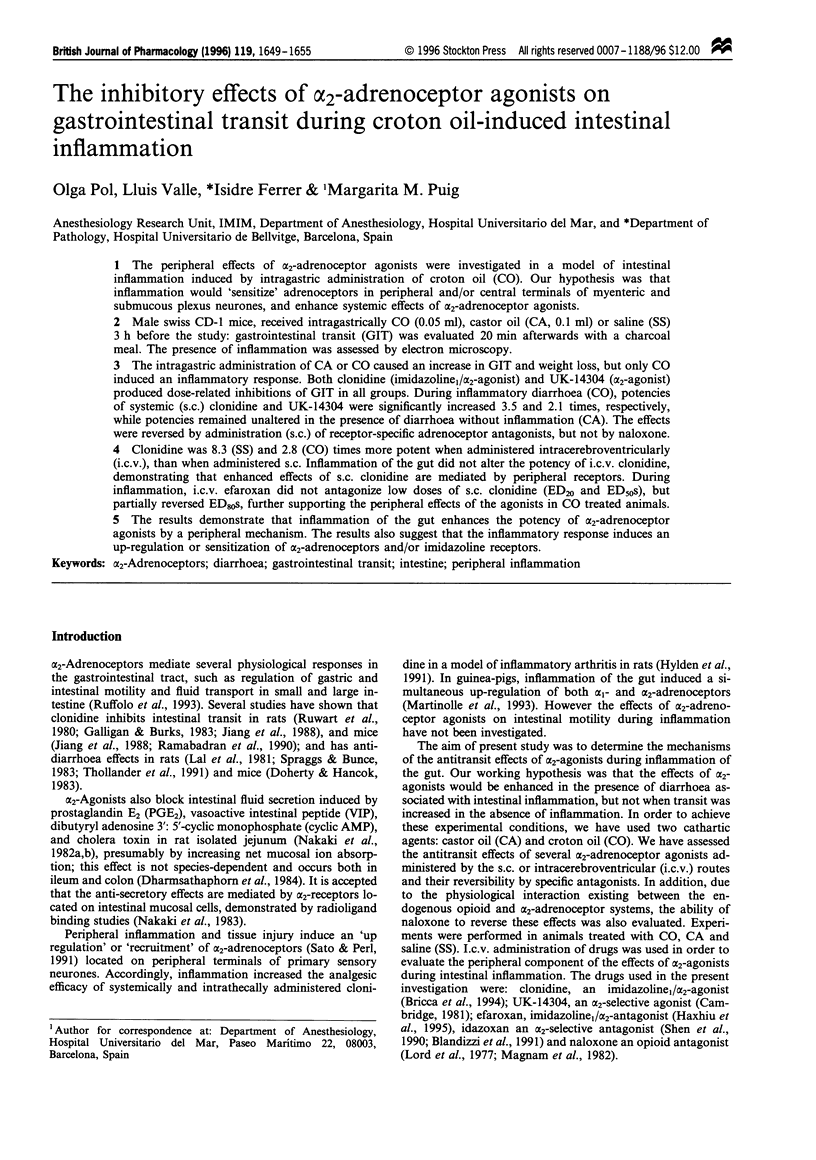
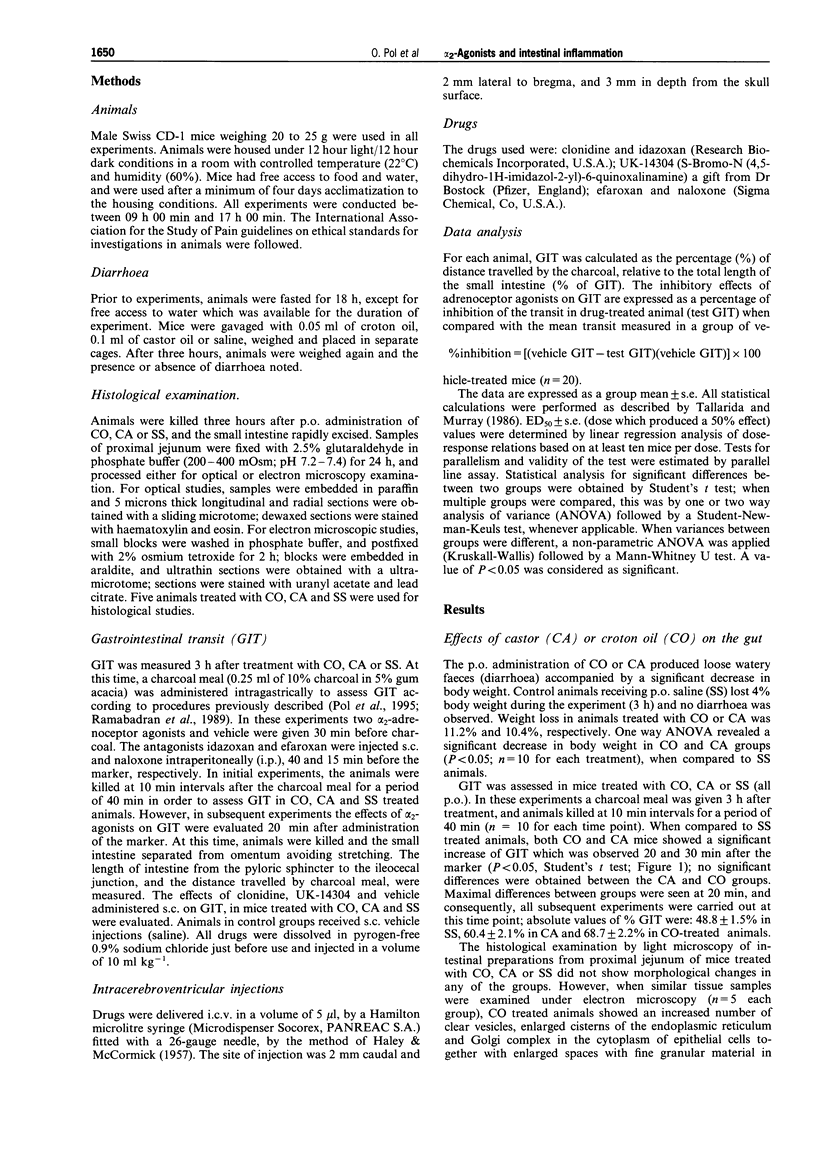
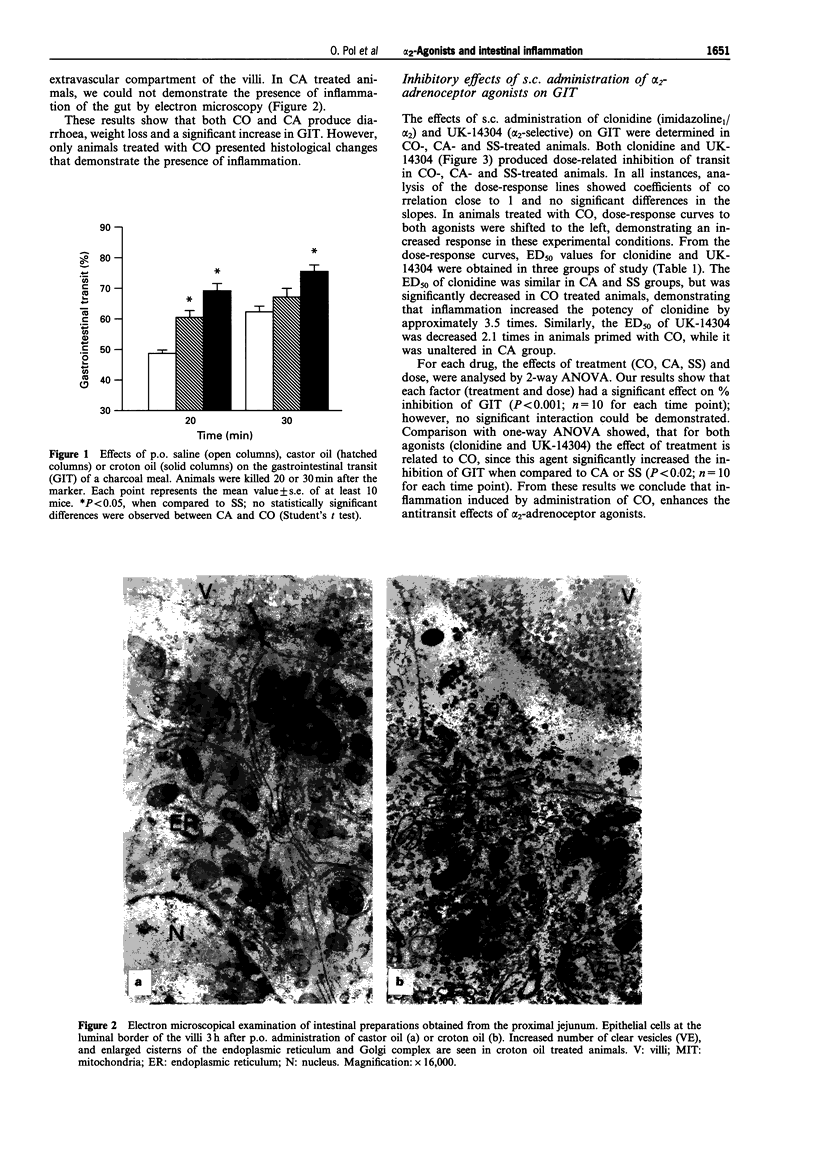
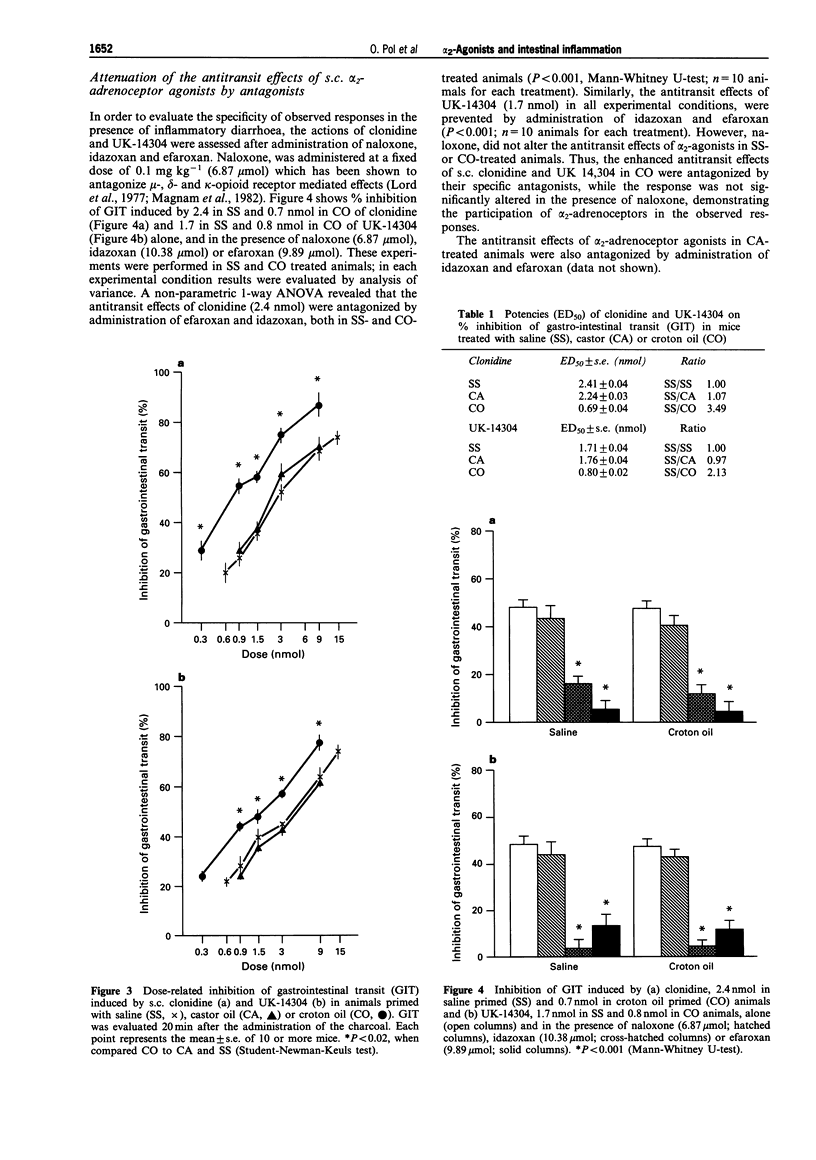
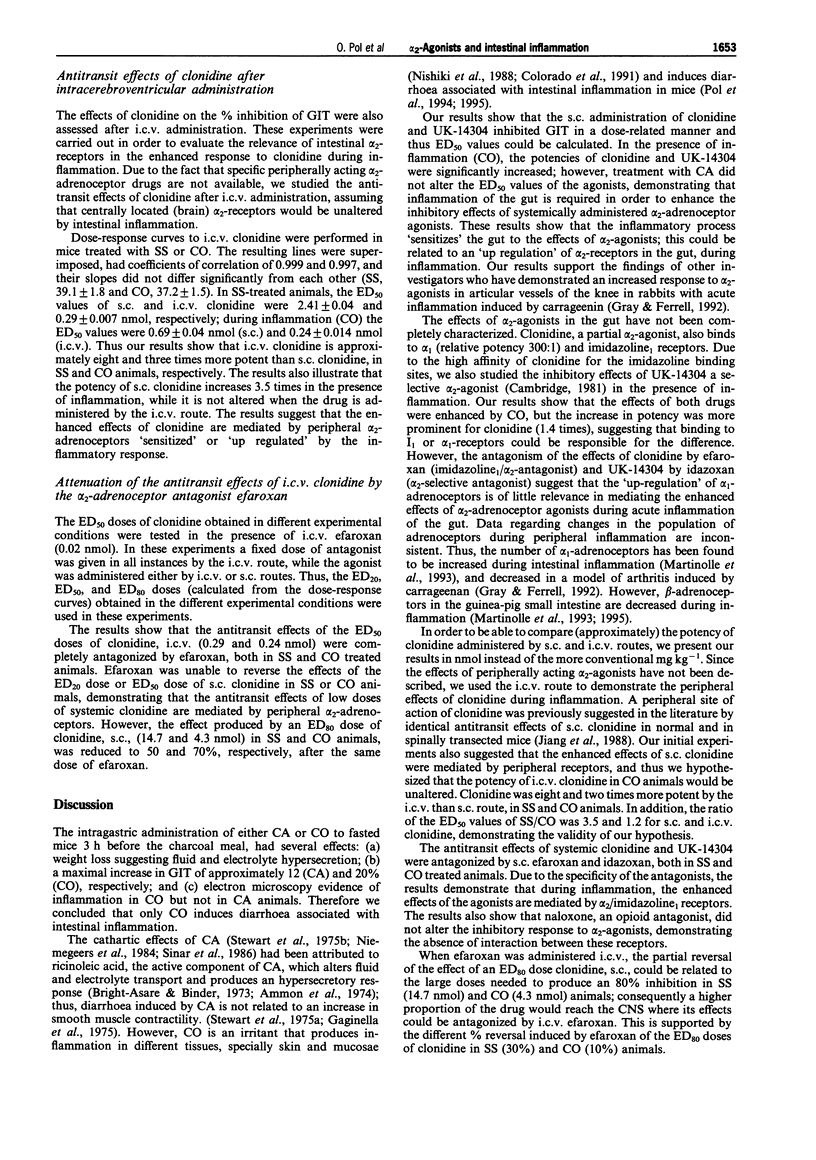
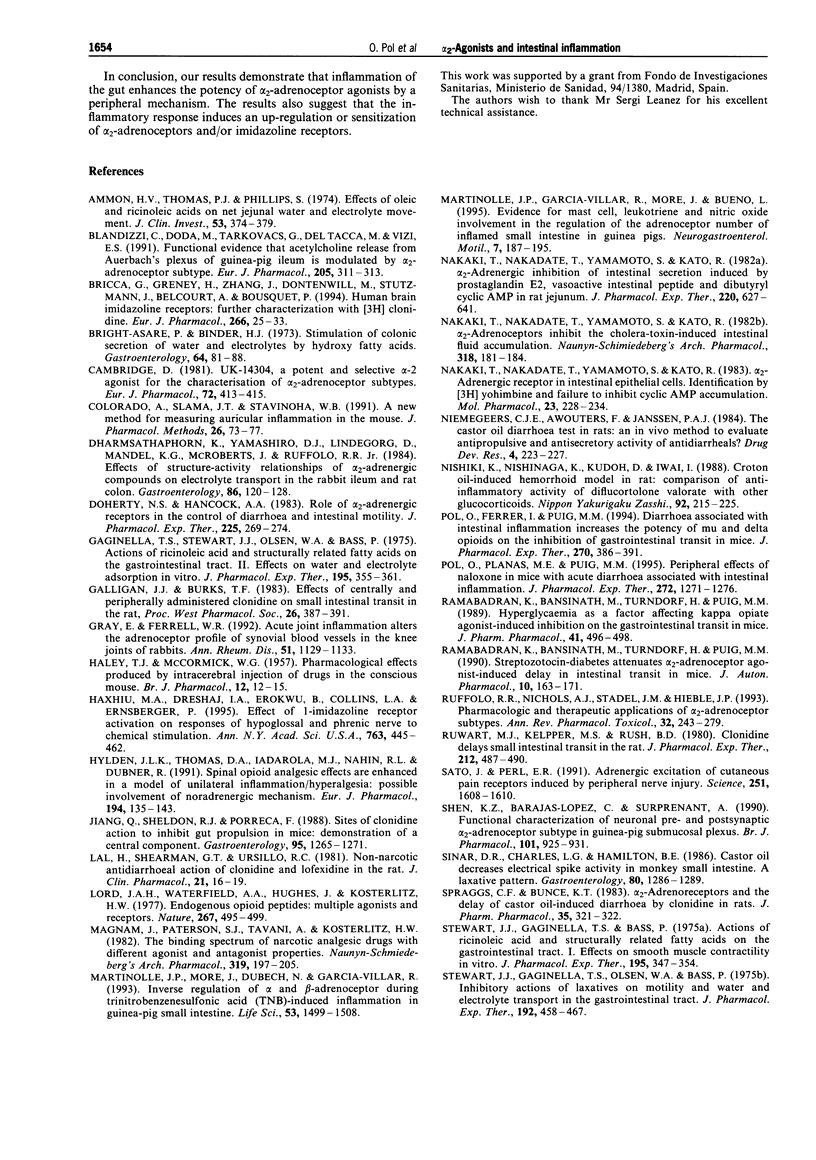

Images in this article
Selected References
These references are in PubMed. This may not be the complete list of references from this article.
- Ammon H. V., Thomas P. J., Phillips S. F. Effects of oleic and ricinoleic acids on net jejunal water and electrolyte movement. Perfusion studies in man. J Clin Invest. 1974 Feb;53(2):374–379. doi: 10.1172/JCI107569. [DOI] [PMC free article] [PubMed] [Google Scholar]
- Blandizzi C., Doda M., Tarkovács G., Del Tacca M., Vizi E. S. Functional evidence that acetylcholine release from Auerbach's plexus of guinea-pig ileum is modulated by alpha 2A-adrenoceptor subtype. Eur J Pharmacol. 1991 Dec 3;205(3):311–313. doi: 10.1016/0014-2999(91)90916-e. [DOI] [PubMed] [Google Scholar]
- Bricca G., Greney H., Zhang J., Dontenwill M., Stutzmann J., Belcourt A., Bousquet P. Human brain imidazoline receptors: further characterization with [3H]clonidine. Eur J Pharmacol. 1994 Jan 1;266(1):25–33. doi: 10.1016/0922-4106(94)90205-4. [DOI] [PubMed] [Google Scholar]
- Bright-Asare P., Binder H. J. Stimulation of colonic secretion of water and electrolytes by hydroxy fatty acids. Gastroenterology. 1973 Jan;64(1):81–88. [PubMed] [Google Scholar]
- Cambridge D. UK-14,304, a potent and selective alpha2-agonist for the characterisation of alpha-adrenoceptor subtypes. Eur J Pharmacol. 1981 Jul 10;72(4):413–415. doi: 10.1016/0014-2999(81)90588-4. [DOI] [PubMed] [Google Scholar]
- Colorado A., Slama J. T., Stavinoha W. B. A new method for measuring auricular inflammation in the mouse. J Pharmacol Methods. 1991 Aug;26(1):73–77. doi: 10.1016/0160-5402(91)90056-b. [DOI] [PubMed] [Google Scholar]
- Dharmsathaphorn K., Yamashiro D. J., Lindeborg D., Mandel K. G., McRoberts J., Ruffolo R. R. Effects of structure-activity relationships of alpha-adrenergic compounds on electrolyte transport in the rabbit ileum and rat colon. Gastroenterology. 1984 Jan;86(1):120–128. [PubMed] [Google Scholar]
- Doherty N. S., Hancock A. A. Role of alpha-2 adrenergic receptors in the control of diarrhea and intestinal motility. J Pharmacol Exp Ther. 1983 May;225(2):269–274. [PubMed] [Google Scholar]
- Gaginella T. S., Stewart J. J., Olsen W. A., Bass P. Actions of ricinoleic acid and structurally related fatty acids on the gastrointestinal tract. II. Effects on water and electrolyte absorption in vitro. J Pharmacol Exp Ther. 1975 Nov;195(2):355–361. [PubMed] [Google Scholar]
- Galligan J. J., Burks T. F. Effects of centrally and peripherally administered clonidine on small intestinal transit in the rat. Proc West Pharmacol Soc. 1983;26:387–391. [PubMed] [Google Scholar]
- Gray E., Ferrell W. R. Acute joint inflammation alters the adrenoceptor profile of synovial blood vessels in the knee joints of rabbits. Ann Rheum Dis. 1992 Oct;51(10):1129–1133. doi: 10.1136/ard.51.10.1129. [DOI] [PMC free article] [PubMed] [Google Scholar]
- HALEY T. J., MCCORMICK W. G. Pharmacological effects produced by intracerebral injection of drugs in the conscious mouse. Br J Pharmacol Chemother. 1957 Mar;12(1):12–15. doi: 10.1111/j.1476-5381.1957.tb01354.x. [DOI] [PMC free article] [PubMed] [Google Scholar]
- Haxhiu M. A., Dreshaj I. A., Erokwu B., Collins L. A., Ernsberger P. Effect of I1-imidazoline receptor activation on responses of hypoglossal and phrenic nerve to chemical stimulation. Ann N Y Acad Sci. 1995 Jul 12;763:445–462. doi: 10.1111/j.1749-6632.1995.tb32435.x. [DOI] [PubMed] [Google Scholar]
- Hylden J. L., Thomas D. A., Iadarola M. J., Nahin R. L., Dubner R. Spinal opioid analgesic effects are enhanced in a model of unilateral inflammation/hyperalgesia: possible involvement of noradrenergic mechanisms. Eur J Pharmacol. 1991 Mar 5;194(2-3):135–143. doi: 10.1016/0014-2999(91)90097-a. [DOI] [PubMed] [Google Scholar]
- Jiang Q., Sheldon R. J., Porreca F. Sites of clonidine action to inhibit gut propulsion in mice: demonstration of a central component. Gastroenterology. 1988 Nov;95(5):1265–1271. doi: 10.1016/0016-5085(88)90360-5. [DOI] [PubMed] [Google Scholar]
- Lal H., Shearman G. T., Ursillo R. C. Nonnarcotic antidiarrheal action of clonidine and lofexidine in the rat. J Clin Pharmacol. 1981 Jan;21(1):16–19. doi: 10.1002/j.1552-4604.1981.tb01726.x. [DOI] [PubMed] [Google Scholar]
- Lord J. A., Waterfield A. A., Hughes J., Kosterlitz H. W. Endogenous opioid peptides: multiple agonists and receptors. Nature. 1977 Jun 9;267(5611):495–499. doi: 10.1038/267495a0. [DOI] [PubMed] [Google Scholar]
- Magnan J., Paterson S. J., Tavani A., Kosterlitz H. W. The binding spectrum of narcotic analgesic drugs with different agonist and antagonist properties. Naunyn Schmiedebergs Arch Pharmacol. 1982 Jun;319(3):197–205. doi: 10.1007/BF00495865. [DOI] [PubMed] [Google Scholar]
- Martinolle J. P., Garcia-Villar R., More J., Bueno L. Evidence for mast cell, leukotriene and nitric oxide involvement in the regulation of the adrenoceptor number of inflamed small intestine in guinea pigs. Neurogastroenterol Motil. 1995 Sep;7(3):187–195. doi: 10.1111/j.1365-2982.1995.tb00224.x. [DOI] [PubMed] [Google Scholar]
- Martinolle J. P., Moré J., Dubech N., Garcia-Villar R. Inverse regulation of alpha- and beta-adrenoceptors during trinitrobenzenesulfonic acid (TNB)-induced inflammation in guinea-pig small intestine. Life Sci. 1993;52(18):1499–1508. doi: 10.1016/0024-3205(93)90112-g. [DOI] [PubMed] [Google Scholar]
- Nakaki T., Nakadate T., Yamamoto S., Kato R. Alpha 2-adrenergic receptor in intestinal epithelial cells. Identification by [3H]yohimbine and failure to inhibit cyclic AMP accumulation. Mol Pharmacol. 1983 Jan;23(1):228–234. [PubMed] [Google Scholar]
- Nakaki T., Nakadate T., Yamamoto S., Kato R. Alpha 2-adrenoceptors inhibit the cholera-toxin-induced intestinal fluid accumulation. Naunyn Schmiedebergs Arch Pharmacol. 1982 Feb;318(3):181–184. doi: 10.1007/BF00500478. [DOI] [PubMed] [Google Scholar]
- Nakaki T., Nakadate T., Yamamoto S., Kato R. Alpha-2 adrenergic inhibition of intestinal secretion induced by prostaglandin E1, vasoactive intestinal peptide and dibutyryl cyclic AMP in rat jejunum. J Pharmacol Exp Ther. 1982 Mar;220(3):637–641. [PubMed] [Google Scholar]
- Nishiki K., Nishinaga K., Kudoh D., Iwai K. [Croton oil-induced hemorrhoid model in rat: comparison of anti-inflammatory activity of diflucortolone valerate with other glucocorticoids]. Nihon Yakurigaku Zasshi. 1988 Oct;92(4):215–225. doi: 10.1254/fpj.92.215. [DOI] [PubMed] [Google Scholar]
- Pol O., Ferrer I., Puig M. M. Diarrhea associated with intestinal inflammation increases the potency of mu and delta opioids on the inhibition of gastrointestinal transit in mice. J Pharmacol Exp Ther. 1994 Jul;270(1):386–391. [PubMed] [Google Scholar]
- Pol O., Planas E., Puig M. M. Peripheral effects of naloxone in mice with acute diarrhea associated with intestinal inflammation. J Pharmacol Exp Ther. 1995 Mar;272(3):1271–1276. [PubMed] [Google Scholar]
- Ramabadran K., Bansinath M., Turndorf H., Puig M. M. Hyperglycaemia as a factor affecting kappa-opiate agonist-induced inhibition of the gastrointestinal transit in mice. J Pharm Pharmacol. 1989 Jul;41(7):496–498. doi: 10.1111/j.2042-7158.1989.tb06511.x. [DOI] [PubMed] [Google Scholar]
- Ramabadran K., Bansinath M., Turndorf H., Puig M. M. Streptozotocin-diabetes attenuates alpha 2-adrenoceptor agonist-induced delay in small intestinal transit in mice. J Auton Pharmacol. 1990 Jun;10(3):163–171. doi: 10.1111/j.1474-8673.1990.tb00015.x. [DOI] [PubMed] [Google Scholar]
- Ruffolo R. R., Jr, Nichols A. J., Stadel J. M., Hieble J. P. Pharmacologic and therapeutic applications of alpha 2-adrenoceptor subtypes. Annu Rev Pharmacol Toxicol. 1993;33:243–279. doi: 10.1146/annurev.pa.33.040193.001331. [DOI] [PubMed] [Google Scholar]
- Ruwart M. J., Klepper M. S., Rush B. D. Clonidine delays small intestinal transit in the rat. J Pharmacol Exp Ther. 1980 Mar;212(3):487–490. [PubMed] [Google Scholar]
- Sato J., Perl E. R. Adrenergic excitation of cutaneous pain receptors induced by peripheral nerve injury. Science. 1991 Mar 29;251(5001):1608–1610. doi: 10.1126/science.2011742. [DOI] [PubMed] [Google Scholar]
- Shen K. Z., Barajas-Lopez C., Surprenant A. Functional characterization of neuronal pre and postsynaptic alpha 2-adrenoceptor subtypes in guinea-pig submucosal plexus. Br J Pharmacol. 1990 Dec;101(4):925–931. doi: 10.1111/j.1476-5381.1990.tb14182.x. [DOI] [PMC free article] [PubMed] [Google Scholar]
- Spraggs C. F., Bunce K. T. Alpha 2-adrenoceptors and the delay of castor oil-induced diarrhoea by clonidine in rats. J Pharm Pharmacol. 1983 May;35(5):321–322. doi: 10.1111/j.2042-7158.1983.tb02943.x. [DOI] [PubMed] [Google Scholar]
- Stewart J. J., Gaginella T. S., Bass P. Actions of ricinoleic acid and structurally related fatty acids of the gastrointestinal tract. I. Effects on smooth muscle contractility in vitro. J Pharmacol Exp Ther. 1975 Nov;195(2):347–354. [PubMed] [Google Scholar]
- Stewart J. J., Gaginella T. S., Olsen W. A., Bass P. Inhibitory actions of laxatives on motility and water and electrolyte transport in the gastrointestinal tract. J Pharmacol Exp Ther. 1975 Feb;192(2):458–467. [PubMed] [Google Scholar]
- Thollander M., Hellström P. M., Svensson T. H. Suppression of castor oil-induced diarrhoea by alpha 2-adrenoceptor agonists. Aliment Pharmacol Ther. 1991 Jun;5(3):255–262. doi: 10.1111/j.1365-2036.1991.tb00026.x. [DOI] [PubMed] [Google Scholar]



